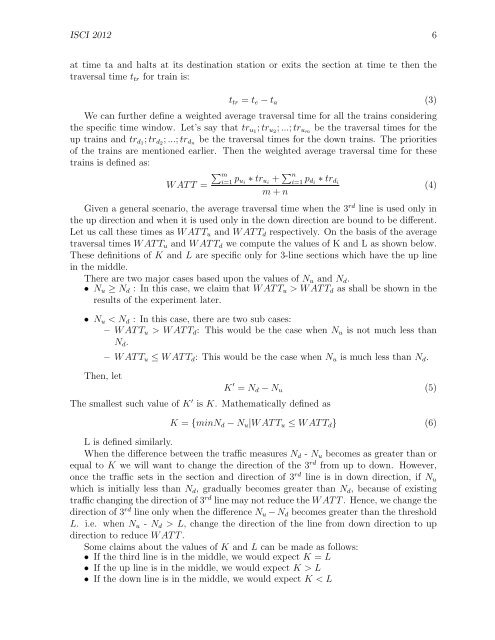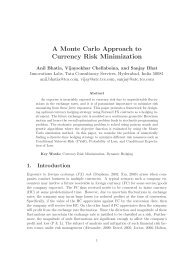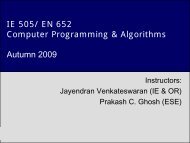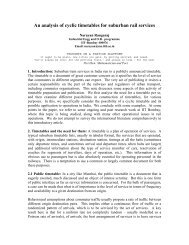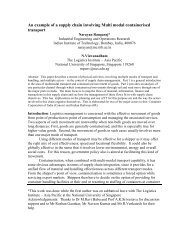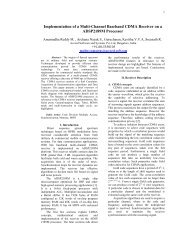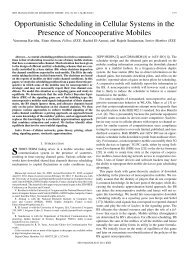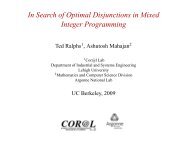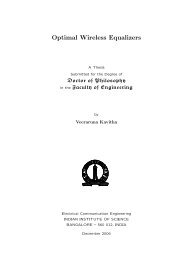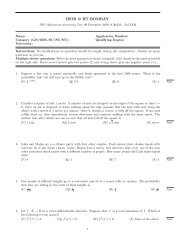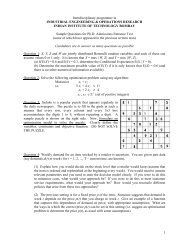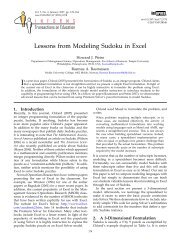Simulation of Multiple Line Rail Sections - IEOR @IIT Bombay ...
Simulation of Multiple Line Rail Sections - IEOR @IIT Bombay ...
Simulation of Multiple Line Rail Sections - IEOR @IIT Bombay ...
You also want an ePaper? Increase the reach of your titles
YUMPU automatically turns print PDFs into web optimized ePapers that Google loves.
ISCI 2012 6<br />
at time ta and halts at its destination station or exits the section at time te then the<br />
traversal time ttr for train is:<br />
ttr = te − ta<br />
We can further define a weighted average traversal time for all the trains considering<br />
the specific time window. Let’s say that tru1; tru2; ...; trum be the traversal times for the<br />
up trains and trd1; trd2; ...; trdn be the traversal times for the down trains. The priorities<br />
<strong>of</strong> the trains are mentioned earlier. Then the weighted average traversal time for these<br />
trains is defined as:<br />
W AT T =<br />
�m i=1 pui ∗ trui + �n pdi i=1 ∗ trdi<br />
m + n<br />
Given a general scenario, the average traversal time when the 3 rd line is used only in<br />
the up direction and when it is used only in the down direction are bound to be different.<br />
Let us call these times as W AT Tu and W AT Td respectively. On the basis <strong>of</strong> the average<br />
traversal times W AT Tu and W AT Td we compute the values <strong>of</strong> K and L as shown below.<br />
These definitions <strong>of</strong> K and L are specific only for 3-line sections which have the up line<br />
in the middle.<br />
There are two major cases based upon the values <strong>of</strong> Nu and Nd.<br />
• Nu ≥ Nd : In this case, we claim that W AT Tu > W AT Td as shall be shown in the<br />
results <strong>of</strong> the experiment later.<br />
• Nu < Nd : In this case, there are two sub cases:<br />
– W AT Tu > W AT Td: This would be the case when Nu is not much less than<br />
Nd.<br />
Then, let<br />
– W AT Tu ≤ W AT Td: This would be the case when Nu is much less than Nd.<br />
K ′ = Nd − Nu<br />
The smallest such value <strong>of</strong> K ′ is K. Mathematically defined as<br />
K = {minNd − Nu|W AT Tu ≤ W AT Td} (6)<br />
L is defined similarly.<br />
When the difference between the traffic measures Nd - Nu becomes as greater than or<br />
equal to K we will want to change the direction <strong>of</strong> the 3 rd from up to down. However,<br />
once the traffic sets in the section and direction <strong>of</strong> 3 rd line is in down direction, if Nu<br />
which is initially less than Nd, gradually becomes greater than Nd, because <strong>of</strong> existing<br />
traffic changing the direction <strong>of</strong> 3 rd line may not reduce the W AT T . Hence, we change the<br />
direction <strong>of</strong> 3 rd line only when the difference Nu − Nd becomes greater than the threshold<br />
L. i.e. when Nu - Nd > L, change the direction <strong>of</strong> the line from down direction to up<br />
direction to reduce W AT T .<br />
Some claims about the values <strong>of</strong> K and L can be made as follows:<br />
• If the third line is in the middle, we would expect K = L<br />
• If the up line is in the middle, we would expect K > L<br />
• If the down line is in the middle, we would expect K < L<br />
(3)<br />
(4)<br />
(5)


